Exploring Summer Variations of Driving Factors Affecting Land Use Zoning Based on the Surface Urban Heat Island in Chiang Mai, Thailand
Abstract
1. Introduction
2. Materials and Methods
2.1. Study Area
2.2. Datasets
2.3. LST Retrieval from Landsat 8 Thermal Band
2.4. Impact of LUZ Categories on LST
2.5. Extraction of Surface Biophysical Parameters
2.6. Identifying the Factors That Influence Driving LST
3. Results
3.1. Changes in LST Retrieval across Different LUZs
3.2. Spatiotemporal Distribution Characteristics and Changes in LST
3.3. Relative Importance of SBPs’ Effects on LST in Different LUZs
4. Discussion
4.1. Summer Variations in Driving Factors on LST
4.2. Effects of Land Use Zoning Block Categories on Summer LSTs
4.3. Implications for Land Use Planning on Urban Climate Changes
4.4. Limitations and Prospective Research
5. Conclusions
Author Contributions
Funding
Data Availability Statement
Acknowledgments
Conflicts of Interest
Appendix A. The Climate Conditions and Precipitation on a Daily Basis during the Study Periods
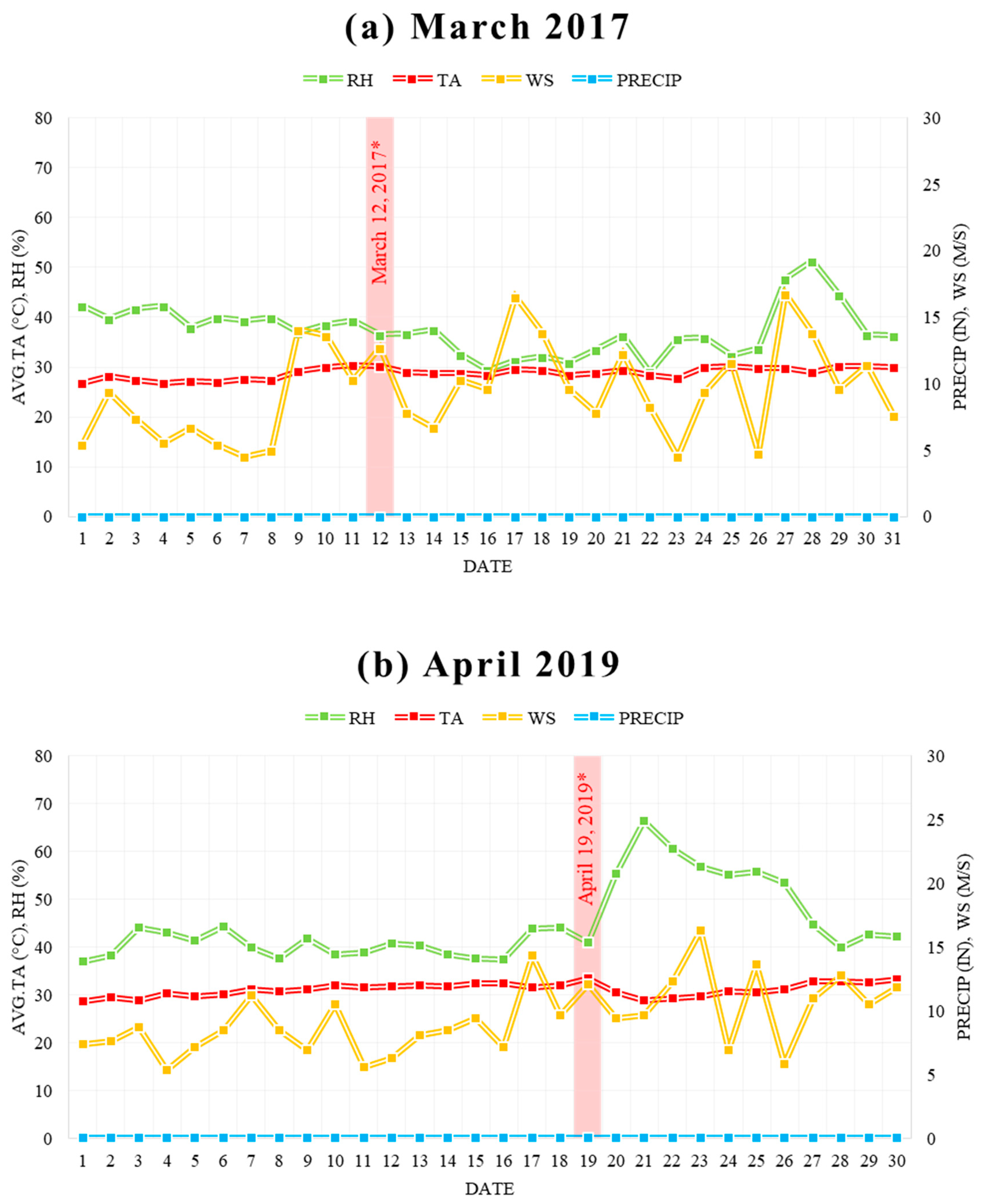

References
- United Nations, Department of Economic and Social Affairs, Population Division. World Population Prospects 2022: Summary of Results; UN DESA/POP/2021/TR/NO. 3; United Nations: New York, NY, USA, 2022.
- Nguyen, C.T.; Chidthaisong, A.; Limsakul, A.; Varnakovida, P.; Ekkawatpanit, C.; Diem, P.K.; Diep, N.T.H. How do disparate urbanization and climate change imprint on urban thermal variations? A comparison between two dynamic cities in Southeast Asia. Sustain. Cities Soc. 2022, 82, 103882. [Google Scholar] [CrossRef]
- Estoque, R.C.; Murayama, Y.; Myint, S.W. Effects of landscape composition and pattern on land surface temperature: An urban heat island study in the megacities of Southeast Asia. Sci. Total Environ. 2017, 577, 349–359. [Google Scholar] [CrossRef] [PubMed]
- Estoque, R.C.; Murayama, Y. Intensity and spatial pattern of urban land changes in the megacities of Southeast Asia. Land Use Policy 2015, 48, 213–222. [Google Scholar] [CrossRef]
- Wang, Y.; Chen, L.; Kubota, J. The relationship between urbanization, energy use and carbon emissions: Evidence from a panel of Association of Southeast Asian Nations (ASEAN) countries. J. Clean. Prod. 2016, 112, 1368–1374. [Google Scholar] [CrossRef]
- Stewart, I.D.; Oke, T.R. Local climate zones for urban temperature studies. Bull. Am. Meteorol. Soc. 2012, 93, 1879–1900. [Google Scholar] [CrossRef]
- Kalnay, E.; Cai, M. Impact of urbanization and land-use change on climate. Nature 2003, 423, 528–531. [Google Scholar] [CrossRef] [PubMed]
- Varnakovida, P.; Ko, H.Y.K. Urban expansion and urban heat island effects on Bangkok metropolitan area in the context of eastern economic corridor. Urban Clim. 2023, 52, 101712. [Google Scholar] [CrossRef]
- Dararat, K.; Shobhakar, D. Time series analysis of land use and land cover changes related to urban heat island intensity: Case of Bangkok metropolitan area in Thailand. J. Urban Manag. 2020, 9, 383–395. [Google Scholar]
- Mokarram, M.; Taripanah, F.; Pham, T.M. Investigating the effect of surface urban heat island on the trend of temperature changes. Adv. Space Res. 2023, 72, 3150–3169. [Google Scholar] [CrossRef]
- Mohammad Harmay, N.S.; Choi, M. The urban heat island and thermal heat stress correlate with climate dynamics and energy budget variations in multiple urban environments. Sustain. Cities Soc. 2023, 91, 104422. [Google Scholar] [CrossRef]
- Verichev, K.; Salazar-Concha, C.; Díaz-López, C.; Carpio, M. The influence of the urban heat island effect on the energy performance of residential buildings in a city with an oceanic climate during the summer period: Case of Valdivia, Chile. Sustain. Cities Soc. 2023, 97, 104766. [Google Scholar] [CrossRef]
- Ulpiani, G. On the linkage between urban heat island and urban pollution island: Three-decade literature review towards a conceptual framework. Sci. Total Environ. 2021, 751, 141727. [Google Scholar] [CrossRef] [PubMed]
- Wang, Y.; Guo, Z.; Han, J. The relationship between urban heat island and air pollutants and them with influencing factors in the Yangtze River Delta, China. Ecol. Indic. 2021, 129, 107976. [Google Scholar] [CrossRef]
- Fahed, J.; Kinab, E.; Ginestet, S.; Adolphe, L. Impact of urban heat island mitigation measures on microclimate and pedestrian comfort in a dense urban district of Lebanon. Sustain. Cities Soc. 2020, 61, 102375. [Google Scholar] [CrossRef]
- Chen, S.; Bao, Z.; Ou, Y.; Chen, K. The synergistic effects of air pollution and urban heat island on public health: A gender-oriented nationwide study of China. Urban Clim. 2023, 51, 101671. [Google Scholar] [CrossRef]
- Hu, D.; Meng, Q.; Schlink, U.; Hertel, D.; Liu, W.; Zhao, M.; Guo, F. How do urban morphological blocks shape spatial patterns of land surface temperature over different seasons? A multifactorial driving analysis of Beijing, China. Int. J. Appl. Earth Obs. Geoinf. 2022, 106, 102648. [Google Scholar] [CrossRef]
- Huang, X.; Wang, Y. Investigating the effects of 3D urban morphology on the surface urban heat island effect in urban func-tional zones by using high-resolution remote sensing data: A case study of Wuhan, Central China. ISPRS J. Photogramm. Remote Sens. 2019, 152, 119–131. [Google Scholar] [CrossRef]
- Weng, Q. Thermal infrared remote sensing for urban climate and environmental studies: Methods, applications, and trends. ISPRS J. Photogramm. Remote Sens. 2009, 64, 335–344. [Google Scholar] [CrossRef]
- Yao, X.; Zhu, Z.; Zhou, X.; Shen, Y.; Shen, X.; Xu, Z. Investigating the effects of urban morphological factors on seasonal land surface temperature in a “Furnace city” from a block perspective. Sustain. Cities Soc. 2022, 86, 104165. [Google Scholar] [CrossRef]
- Li, X.; Yang, B.; Xu, G.; Liang, F.; Jiang, T.; Dong, Z. Exploring the impact of 2-D/3-D building morphology on the land sur-face temperature: A case study of Three Megacities in China. IEEE J. Sel. Top. Appl. Earth Obs. Remote Sens. 2021, 14, 4933–4945. [Google Scholar] [CrossRef]
- Grigoras, G.; Uritescu, B. Land Use/Land Cover changes dynamics and their effects on Surface Urban Heat Island in Bucharest, Romania. Int. J. Appl. Earth Obs. Geoinf. 2019, 80, 115–126. [Google Scholar] [CrossRef]
- Li, B.; Chen, Y.; Shi, X. Does elevation dependent warming exist in high mountain Asia? Environ. Res. Lett. 2020, 15, 024012. [Google Scholar] [CrossRef]
- Kotharkar, R.; Ramesh, A.; Bagade, A. Urban Heat Island studies in South Asia: A critical review. Urban Clim. 2018, 24, 1011–1026. [Google Scholar] [CrossRef]
- Stewart, I.D. A systematic review and scientific critique of methodology in modern urban heat island literature. Int. J. Climatol. 2011, 31, 200–217. [Google Scholar] [CrossRef]
- Iamtrakul, P.; Padon, A.; Chayphong, S. Quantifying the Impact of Urban Growth on Urban Surface Heat Islands in the Bangkok Metropolitan Region, Thailand. Atmosphere 2024, 15, 100. [Google Scholar] [CrossRef]
- Sanecharoen, W.; Nakhapakorn, K.; Mutchimwong, A.; Jirakajohnkool, S.; Onchang, R. Assessment of Urban Heat Island Patterns in Bangkok Metropolitan Area Using Time-Series of LANDSAT Thermal Infrared Data. Environ. Nat. Resour. J. 2019, 17, 87–102. [Google Scholar] [CrossRef]
- Khamchiangta, D.; Dhakal, S. Future urban expansion and local climate zone changes in relation to land surface temperature: Case of Bangkok Metropolitan Administration, Thailand. Urban Clim. 2021, 37, 100835. [Google Scholar] [CrossRef]
- Adulkongkaew, T.; Satapanajaru, T.; Charoenhirunyingyos, S.; Singhirunnusorn, W. Effect of land cover composition and building configuration on land surface temperature in an urban-sprawl city, case study in Bangkok Metropolitan Area, Thailand. Heliyon 2020, 6, e04485. [Google Scholar] [CrossRef] [PubMed]
- Keeratikasikorn, C.; Bonafoni, S. Urban Heat Island Analysis over the Land Use Zoning Plan of Bangkok by Means of Landsat 8 Imagery. Remote Sens. 2018, 10, 440. [Google Scholar] [CrossRef]
- Du, H.Y.; Song, X.J.; Jiang, H.; Kan, Z.H.; Wang, Z.B.; Cai, Y.L. Research on the cooling island effects of water body: A case study of Shanghai, China. Ecol. Indic. 2016, 67, 31–38. [Google Scholar] [CrossRef]
- Simon, O.; Yamungu, N.; Lyimo, J. Simulating land surface temperature using biophysical variables related to building density and height in Dar Es Salaam, Tanzania. Geocarto Int. 2023, 38, 1–18. [Google Scholar] [CrossRef]
- Yao, X.; Zeng, X.; Zhu, Z.; Lan, Y.; Shen, Y.; Liu, Q.; Yang, F. Exploring the diurnal variations of the driving factors affecting block-based LST in a “Furnace city” using ECOSTRESS thermal imaging. Sustain. Cities Soc. 2023, 98, 104841. [Google Scholar] [CrossRef]
- Yao, X.; Zhu, Z.; Zeng, X.; Huang, S.; Liu, Q.; Yu, K.; Zhou, X.; Chen, Z.; Liu, J. Linking maximum-impact and cumula-tive-impact indices to quantify the cooling effect of waterbodies in a subtropical city: A seasonal perspective. Sustain. Cities Soc. 2022, 82, 103902. [Google Scholar] [CrossRef]
- Zhang, Q.; Wu, Z.; Yu, H.; Zhu, X.; Shen, Z. Variable Urbanization Warming Effects across Metropolitans of China and Rel-evant Driving Factors. Remote Sens. 2020, 12, 1500. [Google Scholar] [CrossRef]
- Chen, A.; Lei, Y.; Sun, R.; Chen, L. How many metrics are required to identify the effects of the landscape pattern on land surface temperature? Ecol. Indic. 2014, 45, 424–433. [Google Scholar] [CrossRef]
- Firozjaei, M.K.; Alavipanah, S.K.; Liu, H.; Sedighi, A.; Mijani, N.; Kiavarz, M.; Weng, Q. A PCA–OLS Model for Assessing the Impact of Surface Biophysical Parameters on Land Surface Temperature Variations. Remote Sens. 2019, 11, 2094. [Google Scholar] [CrossRef]
- Thanvisitthpon, N.; Nakburee, A.; Khamchiangta, D.; Saguansap, V. Climate change-induced urban heat Island trend pro-jection and land surface temperature: A case study of Thailand’s Bangkok metropolitan. Urban Clim. 2023, 49, 101484. [Google Scholar] [CrossRef]
- Kottek, M.; Grieser, J.; Beck, C.; Rudolf, B.; Rubel, F. World map of the Köppen-Geiger climate classification updated. Meteor-Ologische Z. 2006, 15, 259–263. [Google Scholar] [CrossRef] [PubMed]
- Rinchumphu, D.; Buosont, P.; Lualai, N.; Ketklin, S.; Timprae, W.; Tepweerakun, S.; Yang, C.Y.; Phichetkunbodee, N. Prediction Model of House Price in Chiang Mai Province. Int. J. Build. Urban Inter. Landsc. 2020, 16, 47–54. [Google Scholar]
- McGrath, B.; Sangawongse, S.; Thaikatoo, T.; Corte, M.B. The Architecture of the Metacity: Land Use Change, Patch Dynamics and Urban Form in Chiang Mai, Thailand. Urban Plan. 2017, 2, 53–71. [Google Scholar] [CrossRef]
- Yang, Q.; Huang, X.; Tang, Q. The Footprint of Urban Heat Island Effect in 302 Chinese Cities: Temporal Trends and Associ-ated Factors. Sci. Total Environ. 2019, 655, 652–662. [Google Scholar] [CrossRef] [PubMed]
- USGS. Landsat 8 (L8) Data Users Handbook; Department of the Interior, U.S. Geological Survey: Reston, VA, USA, 2016.
- Congedo, L. Semi-Automatic Classification Plugin Documentation. Release 5.3.2.1. 2016, pp. 161–164. Available online: https://media.readthedocs.org/pdf/semiautomaticclassificationmanual-v4/latest/semiautomaticclassificationmanual-v4.pdf (accessed on 4 April 2023).
- Sobrino, J.A.; Raissouni, N.; Lit, L.Z. A comparative study of land surface emissivity retrieval from NOAA data. Remote Sens. Environ. 2001, 75, 256–266. [Google Scholar] [CrossRef]
- He, W.; Cao, S.; Du, M.; Hu, D.; Mo, Y.; Liu, M.; Zhao, J.; Cao, Y. How Do Two- and Three-Dimensional Urban Structures Impact Seasonal Land Surface Temperatures at Various Spatial Scales? A Case Study for the Northern Part of Brooklyn, New York, USA. Remote Sens. 2021, 13, 3283. [Google Scholar] [CrossRef]
- Jenks, G.F. Optimal Data Classification for Choropleth Maps; University of Kansas: Lawrence, KS, USA, 1977. [Google Scholar]
- Tian, Y.; Zhou, W.; Qian, Y.; Zheng, Z.; Yan, J. The effect of urban 2D and 3D morphology on air temperature in residential neighborhoods. Landsc. Ecol. 2019, 34, 1161–1178. [Google Scholar] [CrossRef]
- Peng, J.; Liu, Q.; Xu, Z.; Lyu, D.; Du, Y.; Qiao, R.; Wu, J. How to effectively mitigate urban heat island effect? A perspective of waterbody patch size threshold. Landsc. Urban Plan. 2020, 202, 103873. [Google Scholar] [CrossRef]
- Sangawongse, S. Dynamics of Land-Cover/Land-Use in the Chiang Mai Area and Prediction of Urbanization Using the SLEUTH Model. Soc. Sci. Acad. J. 2009, 21, 119–169. [Google Scholar]
- Sangawongse, S.; Ruangrit, V. Towards a GIS-based urban information system to plan a smarter Chiang Mai, NAKHARA. J. Environ. Des. Plan. 2015, 11, 1–8. [Google Scholar]
- Krueathep, W.; Laovakul, D. An Analysis of the Impact of Land and Building Tax Act B.E. 2562 (2019) on the Revenues of Local Administrative Organizations and the Distribution of Tax Burdens. Songklanakarin J. Manag. Sci. 2022, 39, 187–214. [Google Scholar]
- Somsap, C. Problems of using and interpreting the characteristics of land and buildings for taxation regarding to Land and Building Tax B.E. 2562; Case study of Municipality in Chiang Mai. CRRU Law Political Sci. Soc. Sci. J. 2023, 7, 305–323. [Google Scholar]
- USDA. Thailand: Grain and Feed Update, Foreign Argicultural Service; TH2024-0007; USDA: Washington, DC, USA, 2024.
- Essa, W.; Verbeiren, B.; Van Der Kwast, J.; Van De Voorde, T.; Batelaan, O. Evaluation of the DisTrad thermal sharpening methodology for urban areas. Int. J. Appl. Earth Obs. Geoinf. 2012, 19, 163–172. [Google Scholar] [CrossRef]
- Logan, T.M.; Zaitchik, B.; Guikema, S.; Nisbet, A. Night and day: The influence and relative importance of urban character-istics on remotely sensed land surface temperature. Remote Sens. Environ. 2020, 247, 111861. [Google Scholar] [CrossRef]
- Wang, Q.; Wang, X.; Meng, Y.; Zhou, Y.; Wang, H. Exploring the impact of urban features on the spatial variation of land surface temperature within the diurnal cycle. Sustain. Cities Soc. 2023, 91, 104432. [Google Scholar] [CrossRef]
- Hu, Y.; Raza, A.; Syed, N.R.; Acharki, S.; Ray, R.L.; Hussain, S.; Dehghanisanij, H.; Zubair, M.; Elbeltagi, A. Land Use/Land Cover Change Detection and NDVI Estimation in Pakistan’s Southern Punjab Province. Sustainability 2023, 15, 3572. [Google Scholar] [CrossRef]
- Yang, J.; Wang, Y.; Xue, B.; Li, Y.; Xiao, X.; Xia, J.; He, B. Contribution of urban ventilation to the thermal environment and urban energy demand: Different climate background perspectives. Sci. Total Environ. 2021, 795, 148791. [Google Scholar] [CrossRef] [PubMed]
- He, C.; Kin, H.; Hashizume, M.; Lee, W.; Honda, Y.; Kim, S.E.; Kinney, P.L.; Schneider, A.; Zhang, Y.; Zhu, Y.; et al. The effects of night-time warming on mortality burden under future climate change scenarios: A modelling study. Lancet Planet. Health 2022, 6, E648–E657. [Google Scholar] [CrossRef] [PubMed]
- Dontree, S. Relation of Land Surface Temperature (LST) and Land Use/Land Cover (LULC) from Remotely Sensed Data in Chiang Mai–Lamphun Basin. In Proceedings of the SEAGA 2010, Hanoi, Vietnam, 23–26 November 2010. [Google Scholar]
- Charoentrakulpeeti, W.; Mahawan, N. Temporal and spatial dimensions of urban heat island in Chiang Mai. Asian Creat. Archit. Art Des. 2014, 19, 162–172. [Google Scholar]
- Keeratikasikorn, C.; Bonafoni, S. Satellite Images and Gaussian Parameterization for an Extensive Analysis of Urban Heat Islands in Thailand. Remote Sens. 2018, 10, 665. [Google Scholar] [CrossRef]
- Songsom, V.; Suteerasak, T.; Sanwang, P. The relationship between urban heat island and tourism at Chiangmai City, Thailand based on remote sensing. J. King Mongkut’s Univ. Technol. North Bangk. 2020, 30, 678–688. [Google Scholar] [CrossRef]
- Chang, Y.; Xiao, J.; Li, X.; Middel, A.; Zhang, Y.; Gu, Z.; Wu, Y.; He, S. Exploring diurnal thermal variations in urban local climate zones with ECOSTRESS land surface temperature data. Remote Sens. Environ. 2021, 263, 112544. [Google Scholar] [CrossRef]
- Oke, T.R. Boundary layer climates. Earth Sci. Rev. 1987, 27, 265. [Google Scholar]
- Zhao, L.; Lee, X.; Smith, R.B.; Oleson, K. Strong contributions of local background climate to urban heat islands. Nature 2014, 511, 216–219. [Google Scholar] [CrossRef] [PubMed]
- Gunawardena, K.R.; Wells, M.J.; Kershaw, T. Utilising green and blue space to mitigate urban heat island intensity. Sci. Total Environ. 2017, 1040, 584–585. [Google Scholar]
- Sabrin, S.; Karimi, M.; Nazari, R. The cooling potential of various vegetation covers in a heat-stressed underserved community in the deep south: Birmingham, Alabama. Urban Clim. 2023, 51, 101623. [Google Scholar] [CrossRef]
- Lai, D.; Liu, Y.; Liao, M.; Yu, B. Effects of different tree layouts on outdoor thermal comfort of green space in summer Shanghai. Urban Clim. 2023, 47, 101398. [Google Scholar] [CrossRef]
- Sarfo, I.; Bi, S.; Xu, X.; Yeboah, E.; Kwang, C.; Batame, M.; Addai, F.K.; Adamu, U.W.; Appea, E.A.; Djan, M.A.; et al. Planning for cooler cities in Ghana: Contribution of green infrastructure to urban heat mitigation in Kumasi Metropolis. Land Use Policy 2023, 133, 106842. [Google Scholar] [CrossRef]
- Arshad, S.; Ahmad, S.R.; Abbas, S.; Asharf, A.; Siddiqui, N.A.; ul Islam, Z. Quantifying the contribution of diminishing green spaces and urban sprawl to urban heat island effect in a rapidly urbanizing metropolitan city of Pakistan. Land Use Policy 2022, 113, 105874. [Google Scholar] [CrossRef]
- Liou, Y.-A.; Nguyen, K.-A.; Ho, L.-T. Altering urban greenspace patterns and heat stress risk in Hanoi city during Master Plan 2030 implementation. Land Use Policy 2021, 105, 105405. [Google Scholar] [CrossRef]
- Coseo, P.; Larsen, L. How factors of land use/land cover, building configuration, and adjacent heat sources and sinks explain Urban Heat Islands in Chicago. Landsc. Urban Plan. 2014, 125, 117–129. [Google Scholar] [CrossRef]
- Ivajnsic, D.; Kaligaric, M.; Ziberna, I. Geographically weighted regression of the urban heat island of a small city. Appl. Geogr. 2014, 53, 341–353. [Google Scholar] [CrossRef]
- Kim, H.; Jung, Y.; Oh, J.I. Transformation of urban heat island in the three-center city of Seoul, South Korea: The role of master plans. Land Use Policy 2019, 86, 328–338. [Google Scholar] [CrossRef]
- Li, H.; Li, Y.; Wang, T.; Wang, Z.; Gao, M.; Shen, H. Quantifying 3D building form effects on urban land surface temperature and modeling seasonal correlation patterns. Build. Environ. 2021, 204, 108132. [Google Scholar] [CrossRef]
- Suthar, G.; Kaul, N.; Khandelwal, S.; Singh, S. Predicting land surface temperature and examining its relationship with air pollution and urban parameters in Bengaluru: A machine learning approach. Urban Clim. 2024, 53, 101830. [Google Scholar] [CrossRef]
- Zhang, M.; Tan, S.; Liang, J.; Zhang, C.; Chen, E. Predicting the impacts of urban development on urban thermal environment using machine learning algorithms in Nanjing, China. J. Environ. Manag. 2024, 356, 120560. [Google Scholar] [CrossRef] [PubMed]
- Zhao, Z.-D.; Zhao, N.; Ying, N. Association, Correlation, and Causation Among Transport Variables of PM2.5. Front. Phys. 2021, 9, 684104. [Google Scholar] [CrossRef]
- Scarano, M.; Mancini, F. Assessing the relationship between sky view factor and land surface temperature to the spatial resolution. Int. J. Remote Sens. 2017, 38, 6910–6929. [Google Scholar] [CrossRef]
- Sun, F.; Liu, M.; Wang, Y.; Wang, H.; Che, Y. The effects of 3D architectural patterns on the urban surface temperature at a neighborhood scale: Relative contributions and marginal effects. J. Clean. Prod. 2020, 258, 120706. [Google Scholar] [CrossRef]
- Ma, J.; Shen, H.; Wu, P.; Wu, J.; Gao, M.; Meng, C. Generating gapless land surface temperature with a high spatio-temporal resolution by fusing multi-source satellite-observed and model-simulated data. Remote Sens. Environ. 2022, 278, 113083. [Google Scholar] [CrossRef]
- Li, J.; Song, C.; Cao, L.; Zhu, F.; Meng, X.; Wu, J. Impacts of landscape structure on surface urban heat islands: A case study of Shanghai, China. Remote Sens. Environ. 2011, 115, 3249–3263. [Google Scholar] [CrossRef]
- Yu, K.; Chen, Y.H.; Wang, D.D.; Chen, Z.X.; Gong, A.D.; Li, J. Study of the Seasonal Effect of Building Shadows on Urban Land Surface Temperatures Based on Remote Sensing Data. Remote Sens. 2019, 11, 497. [Google Scholar] [CrossRef]

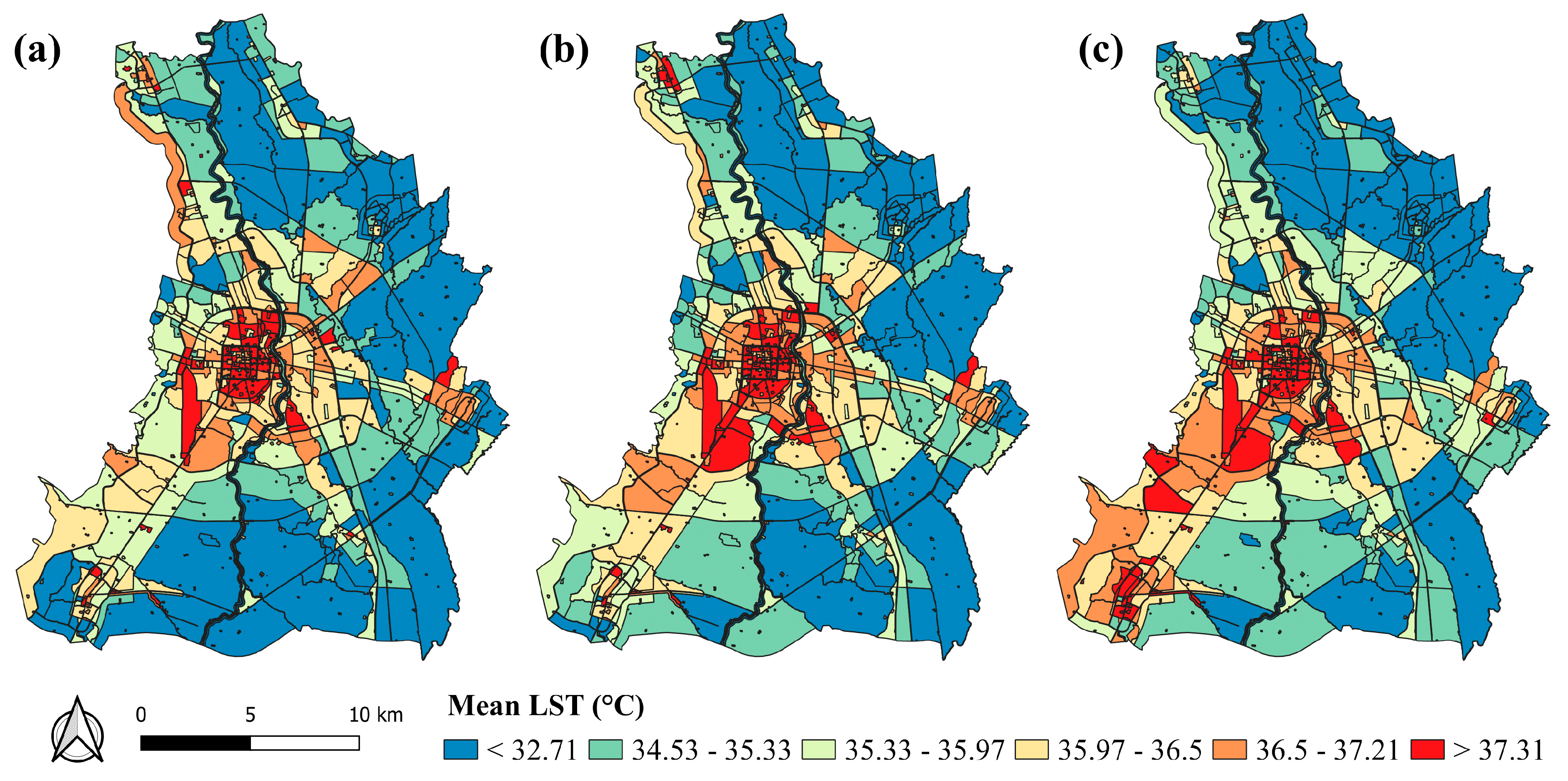
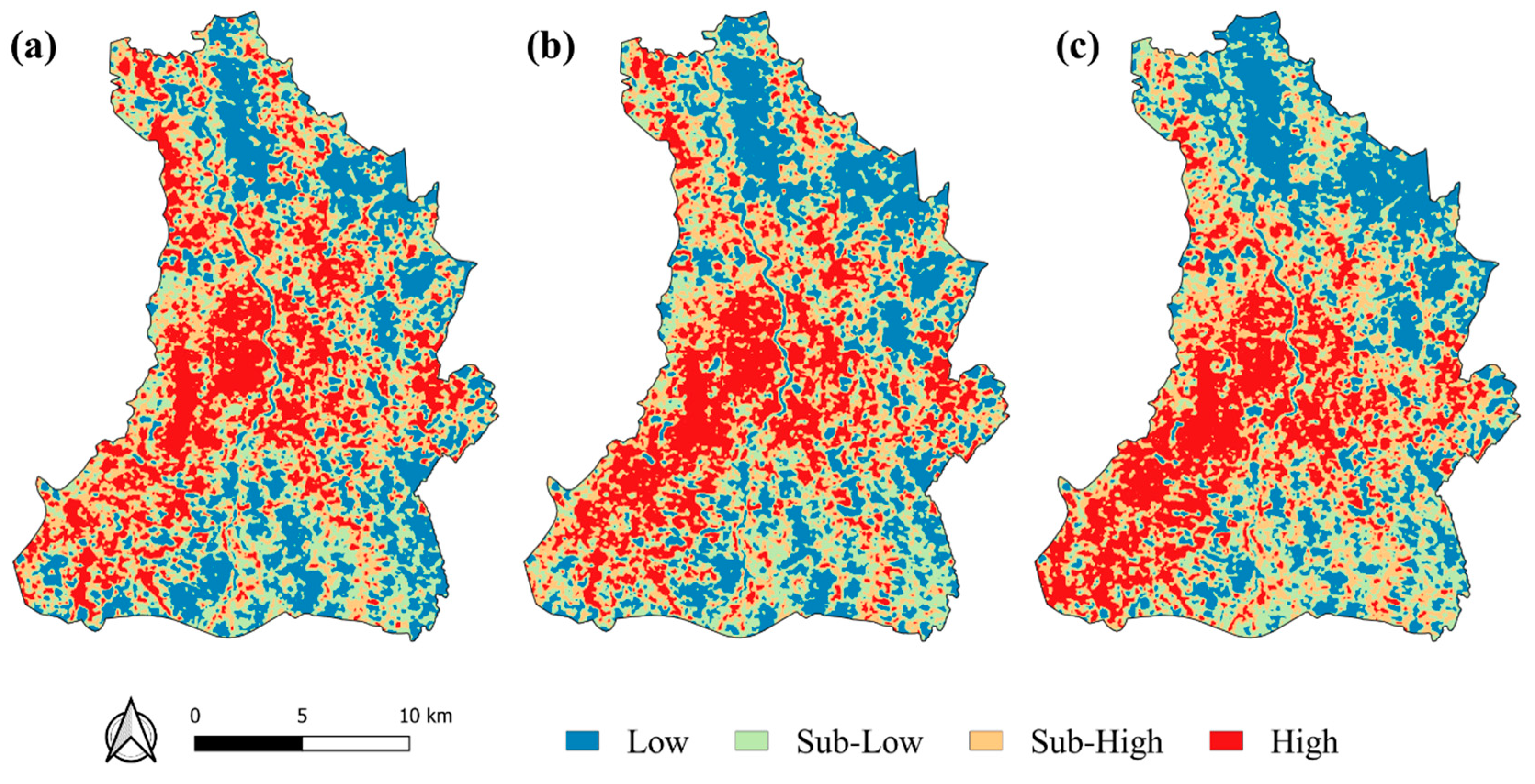
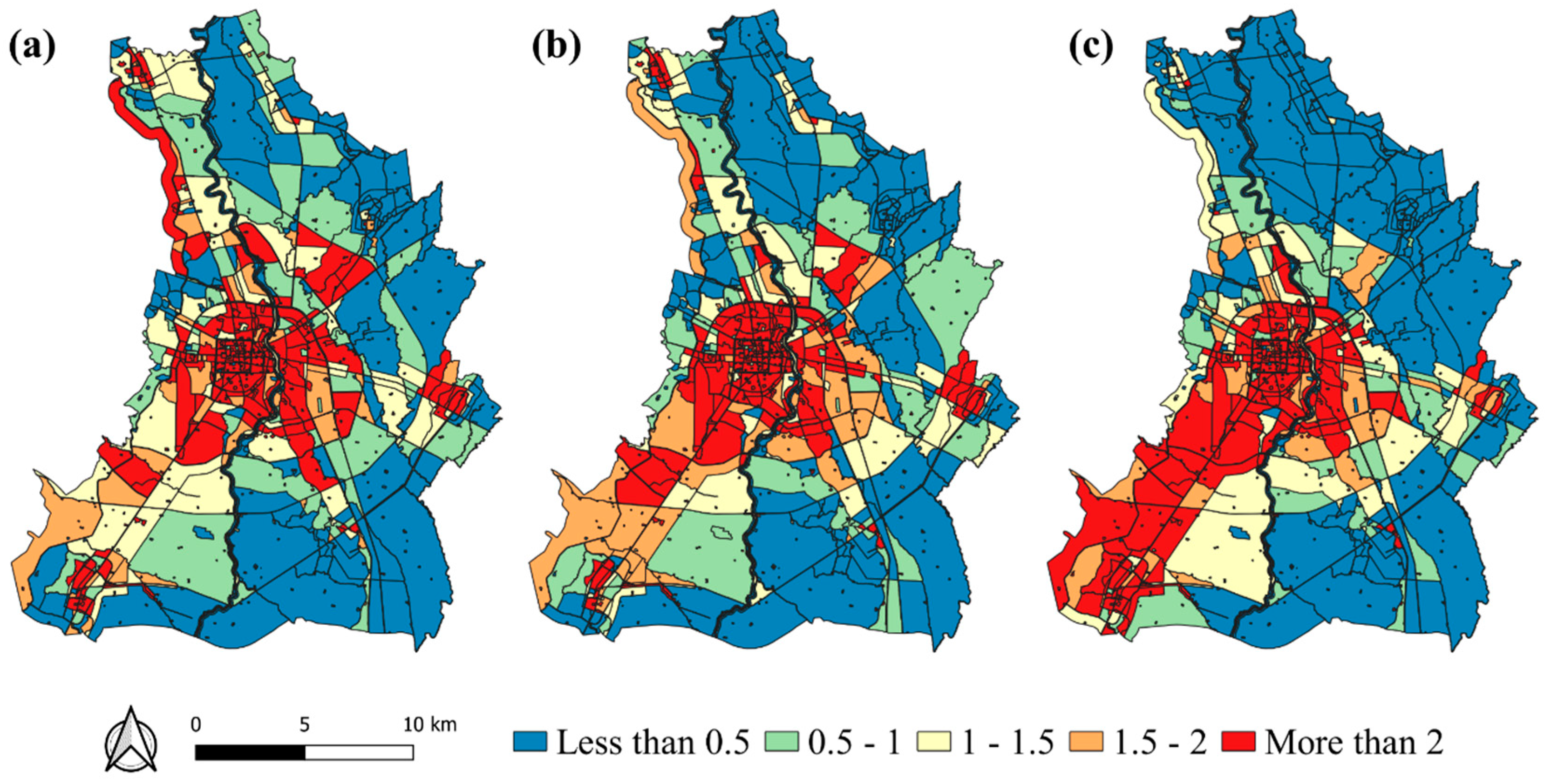






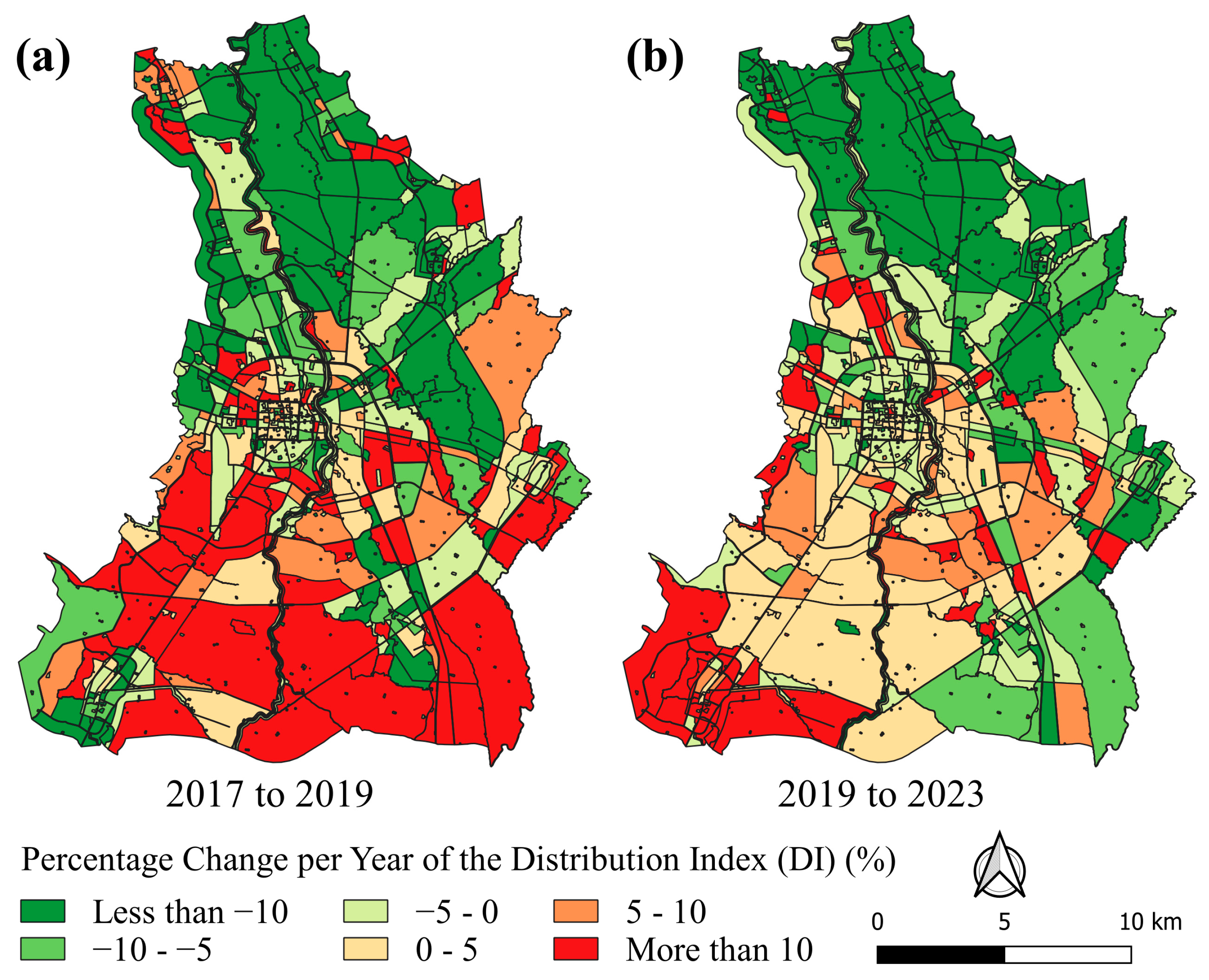
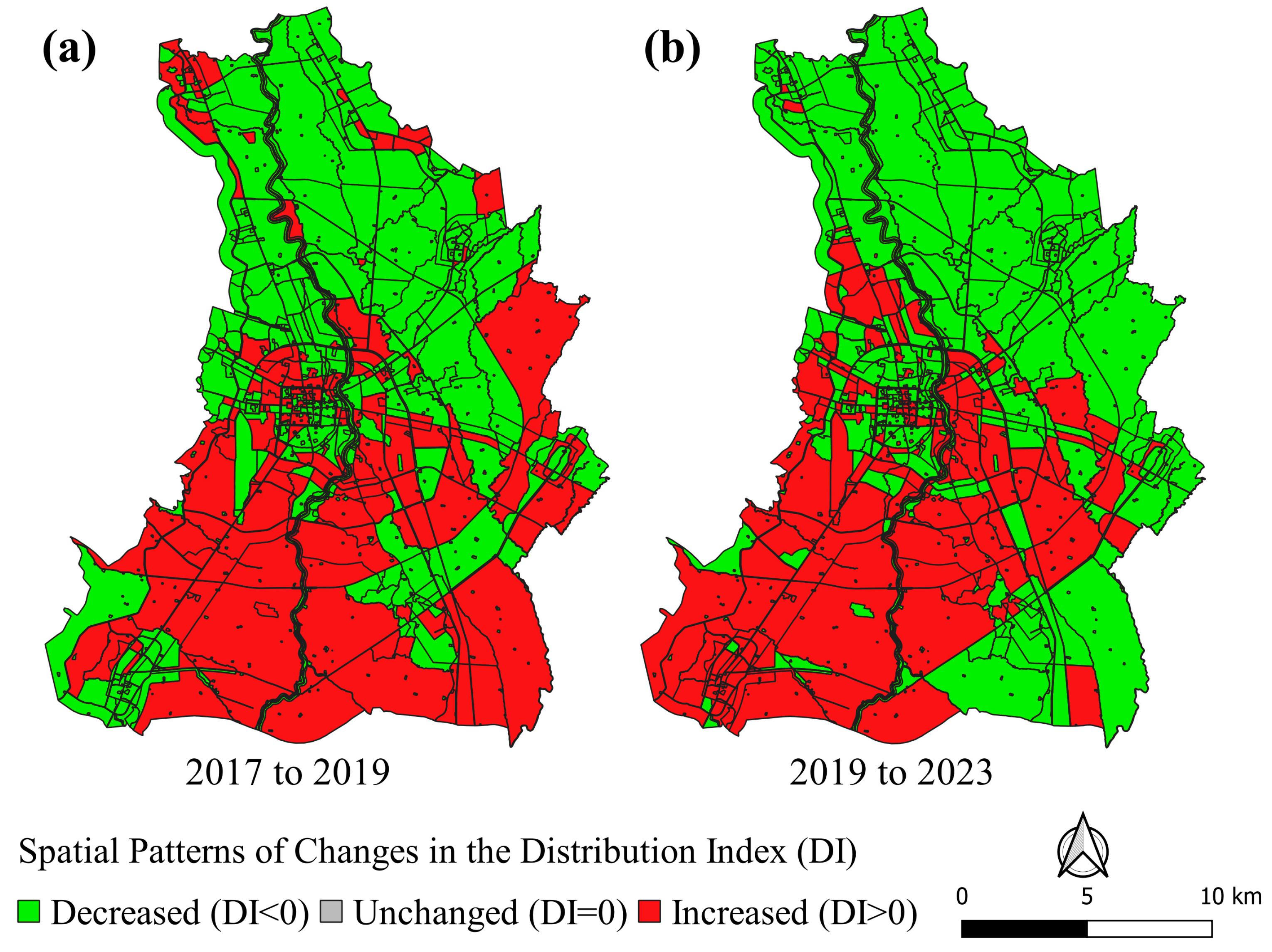

| No | Land Use Zoning (LUZ) | Abbreviation | Area (sq. km) | Percentage (%) | No. of Blocks |
|---|---|---|---|---|---|
| 1 | Residential conservation zone | RC | 2.35 | 0.59 | 11 |
| 2 | Low-density residential zone | LDR | 140.53 | 35.36 | 163 |
| 3 | Medium-density residential zone | MDR | 42.75 | 10.76 | 125 |
| 4 | Commercial and high-density residential zone | C-HDR | 14.80 | 3.72 | 103 |
| 5 | Specific industrial zone | SI | 3.64 | 0.92 | 14 |
| 6 | Educational institution zone | EI | 6.85 | 1.72 | 170 |
| 7 | Rural and agricultural zone | R-A | 149.23 | 37.55 | 61 |
| 8 | Open space for recreation and preserving environmental quality zone | OSR-PEQ | 6.07 | 1.53 | 144 |
| 9 | Preserving and promoting arts and culture zone | P-PAC | 7.48 | 1.88 | 41 |
| 10 | Religious institution zone | RI | 2.17 | 0.55 | 300 |
| 11 | Government institutes, public utilities, and amenities zone | GI-PUA | 5.89 | 1.48 | 138 |
| 12 | Military zone | M | 15.64 | 3.94 | 17 |
| Total | 397.41 | 100.00 | 1270 | ||
| Data | Type | Resolution | Time | Usage | Data Sources |
|---|---|---|---|---|---|
| Remote sensing data | Landsat 8 remotely sensed data. | TIRS data: 100 m; Multispectral data: 30 m | 12 March 2017 3:48 p.m. | LST retrieval and extraction surface biophysical parameters (SBPs) | Satellite images and data of the U.S. Geological Survey (USGS) can be accessed via https://earthexplorer.usgs.gov/ as of 28 April 2023. |
| 19 April 2019 3:48 p.m. | |||||
| 14 April 2023 3:48 p.m. | |||||
| GIS data | Land use zonings (LUZs) | Polygon vector layer | 2012 | LUZ polygons in the 2012 Comprehensive Plan boundary of Chiang Mai were used to summarize raster values (zonal statistics) | Department of Public Works and Town & Country Planning (DPT), Ministry of Interior of the Kingdom of Thailand |
| Variables | Description | Calculation |
|---|---|---|
| (a) Dependent variable | ||
| Land surface temperature (LST) | LST retrieval form Landsat 8 OLI/TIRS (daytime cloudiness below 10%) | Calculated from at-satellite brightness temperature [19] |
| Distribution index (DI) | To examine the influence impact of different LUZs on LST distribution patterns. An LUZ block category with a DI value greater than one (DI > 1) indicates that a significant proportion of the HTC area falls into this category, more so than in the entire study area. | Based on the Jenks natural breaks classification method [46], the highest temperature level is identified as HTC [20] in three temperature categories: high, sub-low, and low. |
| (b) Surface biophysical parameters (SBPs) | ||
| Normalized difference built-up index (NDBI) | The average NDBI in a block | |
| Normalized difference vegetation index (NDVI) | The average NDVI in a block | |
| Modified normalized difference water body index (MNDWI) | The average MNDWI in a block | |
| LUZs | Mean LST (°C) | Annual Rate of Change (°C) | |||
|---|---|---|---|---|---|
| 2017 | 2019 | 2023 | 2017–2019 | 2019–2023 | |
| RC | 32.15 | 35.77 | 35.30 | +1.81 | −0.12 |
| LDR | 31.47 | 35.04 | 34.34 | +1.79 | −0.18 |
| MDR | 32.01 | 35.67 | 34.99 | +1.83 | −0.17 |
| C-HDR | 32.68 | 36.47 | 35.46 | +1.90 | −0.25 |
| SI | 32.67 | 36.62 | 35.91 | +1.97 | −0.18 |
| EI | 32.36 | 36.06 | 35.25 | +1.85 | −0.20 |
| R-A | 31.13 | 34.73 | 33.95 | +1.80 | −0.19 |
| OSR-PEQ | 31.64 | 35.18 | 34.49 | +1.77 | −0.17 |
| P-PAC | 33.08 | 37.03 | 36.14 | +1.97 | −0.22 |
| RI | 32.37 | 36.18 | 35.40 | +1.91 | −0.20 |
| GI-PUA | 32.32 | 36.01 | 35.21 | +1.85 | −0.20 |
| M | 32.80 | 36.62 | 35.82 | +1.91 | −0.20 |
| Overall | 32.13 | 35.83 | 35.05 | +1.85 | −0.19 |
| 2017 | 2019 | ||
| No HTC | HTC | Total | |
| No HTC | 284.85 | 22.34 | 307.19 |
| HTC | 22.31 | 80.23 | 102.54 |
| Total | 307.16 | 102.57 | 409.73 |
| Area change (km2) | +0.02 | −0.02 | - |
| Annual change rate (km2) | +0.01 | −0.01 | - |
| 2019 | 2023 | ||
| No HTC | HTC | Total | |
| No HTC | 282.93 | 24.23 | 307.16 |
| HTC | 24.30 | 78.27 | 102.57 |
| Total | 307.23 | 102.50 | 409.73 |
| Area change (km2) | −0.06 | +0.06 | - |
| Annual change rate (km2) | −0.02 | +0.02 | - |
| LUZs | Average Percentage Annual Rates of Change in DI | 2017 to 2019 (%) | 2019 to 2023 (%) | |||||
|---|---|---|---|---|---|---|---|---|
| 2017–2019 | 2019–2023 | DI < 0 | DI = 0 | DI > 0 | DI < 0 | DI = 0 | DI > 0 | |
| RC | −0.043 | 0.060 | 0.35 | - | 0.25 | 0.02 | 0.01 | 0.58 |
| LDR | −0.029 | 0.021 | 20.61 | - | 15.34 | 20.67 | - | 14.91 |
| MDR | 0.014 | 0.016 | 5.54 | 0.08 | 4.87 | 5.52 | - | 5.18 |
| C-HDR | −0.031 | −0.085 | 1.98 | - | 1.79 | 2.62 | 0.03 | 1.12 |
| SI | 0.067 | 0.009 | 0.35 | - | 0.59 | 0.48 | - | 0.47 |
| EI | −0.109 | −0.014 | 1.49 | - | 0.19 | 0.94 | 0.01 | 0.71 |
| R-A | −0.046 | −0.008 | 12.74 | - | 25.40 | 20.78 | - | 17.76 |
| OSR-PEQ | −0.069 | −0.012 | 0.50 | 0.09 | 0.22 | 0.31 | 0.05 | 0.21 |
| P-PAC | −0.003 | −0.031 | 0.81 | - | 1.06 | 0.89 | - | 0.99 |
| RI | −0.047 | 0.008 | 0.26 | - | 0.05 | 0.09 | 0.01 | 0.22 |
| GI-PUA | −0.090 | −0.035 | 0.99 | 0.03 | 0.39 | 0.73 | - | 0.65 |
| M | −0.122 | −0.044 | 3.13 | - | 0.91 | 2.27 | - | 1.78 |
| Overall | −0.051 | −0.009 | 48.74 | 0.20 | 51.06 | 55.31 | 0.11 | 44.58 |
| LUZs | SBPs | 2017 | 2019 | 2023 | LUZs | SBPs | 2017 | 2019 | 2023 |
|---|---|---|---|---|---|---|---|---|---|
| Overall | NDBI | 0.672 ** | 0.724 ** | 0.668 ** | R-A | NDBI | 0.775 ** | 0.808 ** | 0.728 ** |
| (n = 1270) | NDVI | −0.587 ** | −0.650 ** | −0.580 ** | (n = 61) | NDVI | −0.509 ** | −0.614 ** | −0.391 ** |
| MNDWI | −0.183 ** | −0.281 ** | −0.446 ** | MNDWI | −0.654 ** | −0.641 ** | −0.722 ** | ||
| RC | NDBI | 0.521 | 0.493 | 0.360 | OSR-PEQ | NDBI | 0.652 ** | 0.656 ** | 0.635 ** |
| (n = 11) | NDVI | −0.079 | −0.155 | 0.002 | (n = 144) | NDVI | −0.330 ** | −0.401 ** | −0.348 ** |
| MNDWI | −0.283 | −0.567 | −0.334 | MNDWI | −0.333 ** | −0.364 ** | −0.485 ** | ||
| LDR | NDBI | 0.774 ** | 0.841 ** | 0.771 ** | P-PAC | NDBI | 0.781 ** | 0.842 ** | 0.733 ** |
| (n = 162) | NDVI | −0.575 ** | −0.726 ** | −0.515 ** | (n = 41) | NDVI | −0.738 ** | −0.823 ** | −0.761 ** |
| MNDWI | −0.662 ** | −0.698 ** | −0.742 ** | MNDWI | −0.035 | −0.337 * | −0.343 * | ||
| MDR | NDBI | 0.726 ** | 0.849 ** | 0.775 ** | RI | NDBI | 0.457 ** | 0.537 ** | 0.514 ** |
| (n = 125) | NDVI | −0.709 ** | −0.813 ** | −0.696 ** | (n = 299) | NDVI | −0.620 ** | −0.649 ** | −0.606 ** |
| MNDWI | −0.041 | −0.425 ** | −0.664 ** | MNDWI | 0.186 ** | 0.092 | −0.139 * | ||
| C-HDR | NDBI | 0.788 ** | 0.868 ** | 0.777 ** | GI-PUA | NDBI | 0.358 ** | 0.495 ** | 0.473 ** |
| (n = 103) | NDVI | −0.638 ** | −0.742 ** | −0.672 ** | (n = 138) | NDVI | −0.340 ** | −0.471 ** | −0.535 ** |
| MNDWI | −0.114 | −0.269 ** | −0.536 ** | MNDWI | −0.043 | −0.135 | −0.184 * | ||
| SI | NDBI | 0.924 ** | 0.816 ** | 0.741 ** | M | NDBI | 0.915 ** | 0.842 ** | 0.905 ** |
| (n = 14) | NDVI | −0.810 ** | −0.814 ** | −0.682 ** | (n = 17) | NDVI | −0.724 ** | −0.705 ** | −0.839 ** |
| MNDWI | −0.524 | −0.440 | −0.648 * | MNDWI | −0.411 | −0.432 | −0.632 ** | ||
| EI | NDBI | 0.529 ** | 0.577 ** | 0.509 | |||||
| (n = 170) | NDVI | −0.538 ** | −0.583 ** | −0.478 ** | Low |  | High | ||
| MNDWI | 0.002 | 0.074 | 0.275 | ||||||
| Block Categories | NDBI | NDVI | MNDWI | Constant | R2 | Adj.R2 | SEE | F |
|---|---|---|---|---|---|---|---|---|
| 2017 | ||||||||
| All | 13.948 ** | −3.131 ** | × | 33.093 ** | 0.459 | 0.458 | 0.832 | 545.055 ** |
| RC | - | - | - | - | no | no | no | no |
| LDR | 18.518 ** | × | −13.697 ** | 30.111 ** | 0.66 | 0.656 | 0.647 | 154.384 ** |
| MDR | × | −15.647 ** | −10.542 ** | 33.648 ** | 0.567 | 0.56 | 0.602 | 80.034 ** |
| C-HDR | 16.826 ** | × | × | 32.755 ** | 0.621 | 0.617 | 0.578 | 165.268 ** |
| SI | 19.336 ** | × | × | 32.794 ** | 0.854 | 0.842 | 0.316 | 70.387 ** |
| EI | 7.194 ** | −6.964 ** | × | 33.788 ** | 0.33 | 0.322 | 0.786 | 41.158 ** |
| R-A | 20.323 ** | × | × | 32.575 ** | 0.601 | 0.595 | 0.641 | 88.973 ** |
| OSR-PEQ | 16.889 ** | × | × | 32.367 ** | 0.425 | 0.421 | 0.921 | 104.994 ** |
| P-PAC | 18.092 ** | × | × | 32.995 ** | 0.61 | 0.6 | 0.691 | 61.072 ** |
| RI | × | −17.867 ** | × | 35.798 ** | 0.385 | 0.383 | 0.859 | 185.738 ** |
| GI-PUA | 7.098 ** | × | × | 32.407 ** | 0.128 | 0.122 | 0.83 | 19.989 ** |
| M | 30.529 ** | × | × | 33.093 ** | 0.837 | 0.827 | 0.524 | 77.233 ** |
| 2019 | ||||||||
| All | 16.014 ** | −4.183 ** | × | 37.209 ** | 0.532 | 0.531 | 0.975 | 728.891 ** |
| RC | - | - | - | - | no | no | no | no |
| LDR | 26.429 ** | × | × | 36.756 ** | 0.707 | 0.705 | 0.787 | 385.605 ** |
| MDR | 17.092 ** | −6.43 ** | × | 37.948 ** | 0.73 | 0.725 | 0.69 | 164.625 ** |
| C-HDR | 20.036 ** | × | × | 36.575 ** | 0.753 | 0.751 | 0.601 | 308.281 ** |
| SI | 18.242 ** | × | × | 36.659 ** | 0.666 | 0.639 | 0.599 | 23.965 ** |
| EI | 7.768 ** | −8.512 ** | × | 37.994 ** | 0.374 | 0.367 | 0.955 | 49.99 ** |
| R-A | 23.982 ** | × | × | 36.404 ** | 0.653 | 0.647 | 0.691 | 111.099 ** |
| OSR-PEQ | 17.034 ** | × | × | 36.009 ** | 0.431 | 0.427 | 1.079 | 107.504 ** |
| P-PAC | 19.361 ** | × | × | 36.879 ** | 0.709 | 0.701 | 0.737 | 94.795 ** |
| RI | × | −21.619 ** | × | 40.692 ** | 0.421 | 0.419 | 1.034 | 216.253 ** |
| GI-PUA | 10.544 ** | × | × | 36.251 ** | 0.245 | 0.24 | 0.987 | 44.244 ** |
| M | 35.43 ** | × | × | 37.418 ** | 0.708 | 0.689 | 0.976 | 36.43 ** |
| 2023 | ||||||||
| All | 15.047 ** | −5.383 ** | × | 36.629 ** | 0.457 | 0.497 | 1.047 | 540.192 ** |
| RC | - | - | - | - | no | no | no | no |
| LDR | 19.519 ** | −14.118 ** | × | 33.593 ** | 0.623 | 0.618 | 0.938 | 131.232 ** |
| MDR | 22.481 ** | × | × | 35.678 ** | 0.6 | 0.597 | 0.933 | 184.532 ** |
| C-HDR | 18.793 ** | × | × | 35.394 ** | 0.603 | 0.599 | 0.766 | 153.606 ** |
| SI | 16.8 ** | × | × | 35.833 ** | 0.549 | 0.512 | 0.677 | 14.625 ** |
| EI | 9.246 ** | −7.667 * | × | 36.704 ** | 0.283 | 0.274 | 1.093 | 32.911 ** |
| R-A | 14.108 ** | × | −14.461 * | 32.726 ** | 0.563 | 0.548 | 0.818 | 37.397 ** |
| OSR-PEQ | 14.631 ** | × | × | 35.057 ** | 0.404 | 0.399 | 0.965 | 96.066 ** |
| P-PAC | × | −16.788 ** | × | 38.784 ** | 0.579 | 0.569 | 0.753 | 53.742 ** |
| RI | × | −24.505 ** | −5.303 * | 38.924 ** | 0.379 | 0.375 | 1.076 | 90.42 ** |
| GI-PUA | × | −14.168 ** | −5.148 * | 37.039 ** | 0.318 | 0.308 | 0.969 | 31.491 ** |
| M | 36.842 ** | × | × | 36.827 ** | 0.819 | 0.806 | 0.877 | 67.686 ** |
| Rankings of SBPs’ effects on LUZ block categories. | Low |  | High | |||||
Disclaimer/Publisher’s Note: The statements, opinions and data contained in all publications are solely those of the individual author(s) and contributor(s) and not of MDPI and/or the editor(s). MDPI and/or the editor(s) disclaim responsibility for any injury to people or property resulting from any ideas, methods, instructions or products referred to in the content. |
© 2024 by the authors. Licensee MDPI, Basel, Switzerland. This article is an open access article distributed under the terms and conditions of the Creative Commons Attribution (CC BY) license (https://creativecommons.org/licenses/by/4.0/).
Share and Cite
Rinchumphu, D.; Srivanit, M.; Iamchuen, N.; Aryupong, C. Exploring Summer Variations of Driving Factors Affecting Land Use Zoning Based on the Surface Urban Heat Island in Chiang Mai, Thailand. ISPRS Int. J. Geo-Inf. 2024, 13, 228. https://doi.org/10.3390/ijgi13070228
Rinchumphu D, Srivanit M, Iamchuen N, Aryupong C. Exploring Summer Variations of Driving Factors Affecting Land Use Zoning Based on the Surface Urban Heat Island in Chiang Mai, Thailand. ISPRS International Journal of Geo-Information. 2024; 13(7):228. https://doi.org/10.3390/ijgi13070228
Chicago/Turabian StyleRinchumphu, Damrongsak, Manat Srivanit, Niti Iamchuen, and Chuchoke Aryupong. 2024. "Exploring Summer Variations of Driving Factors Affecting Land Use Zoning Based on the Surface Urban Heat Island in Chiang Mai, Thailand" ISPRS International Journal of Geo-Information 13, no. 7: 228. https://doi.org/10.3390/ijgi13070228
APA StyleRinchumphu, D., Srivanit, M., Iamchuen, N., & Aryupong, C. (2024). Exploring Summer Variations of Driving Factors Affecting Land Use Zoning Based on the Surface Urban Heat Island in Chiang Mai, Thailand. ISPRS International Journal of Geo-Information, 13(7), 228. https://doi.org/10.3390/ijgi13070228







